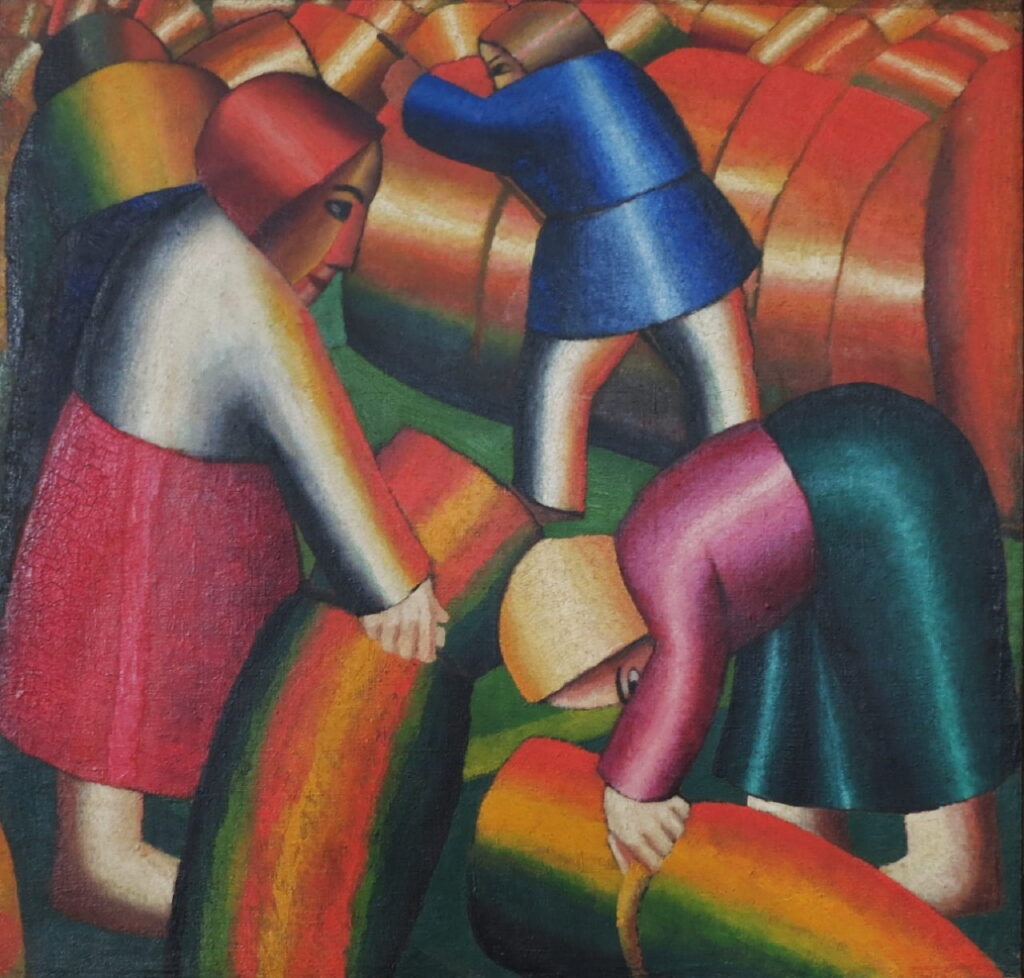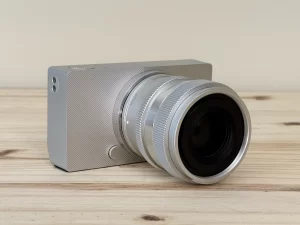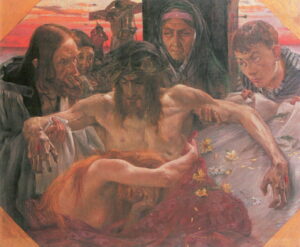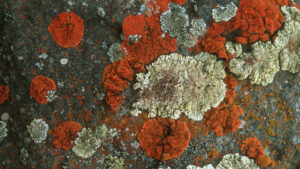Paintings from Ukraine 2

This is the second of this weekend’s two articles in which the artists and paintings of Ukraine tell their own story. Each of the links given takes you back to the series of articles I compiled here a couple of years ago.
By the end of the nineteenth century, Ukrainian art schools were at last training the Ukrainian artists of the future, who were able to make their own styles and develop distinctive movements. Among them were some who went on to earn a place internationally. Unfortunately, history conspired to change all this in the political unrest around the October 1917 Revolution in Russia, and through two World Wars. As a result, the lives of many Ukrainian artists were brought to an early end, by disease, starvation, or execution. A large proportion of their output has been deliberately suppressed, hidden away in collections of banned works, destroyed, or looted.
Mykola Pymonenko (1862–1912), Waiting for the Blessing (1891), oil on canvas, 133 x 193 cm, Rybinsk Museum-Preserve Рыбинский историко-архитектурный и художественный музей-заповедник, Rybinsk, Russia. Wikimedia Commons.
Mykola Pymonenko (1862–1912), Harvest in Ukraine (1896), oil on canvas, 87 x 140 cm, location not known. Wikimedia Commons.
Mykola Pymonenko (1862–1912) was born in a village outside Kyiv and started his training in his father’s icon workshop in the city, prior to his discovery by Mykola Murashko of the Kyiv Art School, where he trained before heading off to Saint Petersburg. He returned to Kyiv in 1884 to teach and to paint in the Naturalist style that was so popular at the Salon in Paris at the time. It was he who perhaps painted the first distinctively Ukrainian works that drew on local themes such as Paska at Easter, traditional weddings and the grain harvest. Kazymyr Malevych was among his pupils.
Mykola Ivasyuk (1865–1937), Entry of Bohdan Khmelnytskyi to Kyiv in 1649 (date not known), media not known, 350 x 550 cm, National Art Museum of Ukraine Національний художній музей України, Kyiv, Ukraine. Wikimedia Commons.
Many Ukrainian artists had depicted Zaporozhian Cossacks, and they remained a favourite theme for Ilia Repin right up to his death, but the first prominent specialist national history painter was Mykola Ivasyuk (1865–1937), who was born and brought up in Zastavna in western Ukraine when it was still part of the Austro-Hungarian Empire. He therefore trained at the Academy of Fine Arts in Vienna, but chose to spend much of his career in Chernivtsi and Kyiv, where he also taught.
During the nineteenth century, the evolution of painting in Ukraine had largely been constrained by the orthodoxy of the Imperial Academy, and the supply of Russian patrons. As its own art schools flourished, and support for the arts grew, the pace of progress rose rapidly in Ukraine. The first decade of the twentieth century saw Ukrainian artists in the same avant garde as those in France and the rest of Europe, until the First World War and the October 1917 Revolution.
The war threw Ukraine into the midst of the conflict between Austro-Hungary and Russia, with Ukrainians fighting one another on behalf of two different empires. Then from 1917 onwards, the country lapsed in and out of complete chaos. By 1920, many Ukrainian artists had been forced to leave, or were intending to do so.
For painters like Ivasyuk, the world changed too rapidly. Initially he was commissioned to design postage stamps, then in 1926 he was made a professor at the Kyiv Art Institute. In a few years he had been moved away to Odesa as a result of political criticism. In the autumn of 1937, he was arrested, convicted of terrorism on the basis of his history paintings, and was shot by a firing squad at the age of seventy-two. Many of his paintings were confiscated or destroyed in a bid to erase him and his work completely.
Viktor Zarubin (1866–1928), Voice of Silence (1907), oil on canvas, 72 x 89.5 cm, location not known. Wikimedia Commons.
Viktor Zarubin (1866–1928) was born in Kharkiv, trained under Arkhyp Kuindzhi, and painted extensively in Ukraine and northern France.
Ivan Trush (1869–1941), Hutsul Girls (1933), media and dimensions not known, Lviv National Art Gallery, Lviv, Ukraine. Wikimedia Commons.
Ivan Trush (1869–1941) was born in Vysotsko, to the north-east of Lviv. He settled in the city, where he was involved in the establishment of Lviv National Museum. He was a prominent portraitist, and painted Impressionist landscapes.
Petro Nilus (1869–1943), On the Bridge (c 1910), further details not known. Wikimedia Commons.
Petro Nilus (1869–1943) was born in Balta, in south-west Ukraine, and moved to Odesa, where he studied under Kyriak Kostandi. He was active in Odesa for much of his career until moving to Paris in 1920.
Mykola Burachek (1871–1942), The Mighty Dnipro Roars and Bellows… (1941), oil on canvas, 100 x 135 cm, National Museum Тaras Shevchenko, Kyiv, Ukraine. Wikimedia Commons.
Mykola Burachek (1871-1942) was born in Letychiv, western Ukraine, and trained under Khariton Platonov in Kyiv. He taught in Kyiv from 1917, then in Kharkiv from 1925. He died there during its Nazi occupation.
Oleksandr Murashko (1875–1919), Annunciation (1907-08), oil on canvas, 198 x 169 cm, National Art Museum of Ukraine Національний художній музей України, Kyiv, Ukraine. Wikimedia Commons.
Oleksandr Murashko (1875–1919) was born in Kyiv, where he became a major figurative painter. He taught there from 1909, and was a co-founder of the Ukrainian State Academy of Arts. He was shot dead by a street gang.
Kazimierz Sichulski (1879–1942), Adoration of the Shepherds triptych (1938), oil on canvas, 102 x 222 cm, Private collection. Wikimedia Commons.
Kazimierz Sichulski (1879–1942) was born in Lviv. He travelled in the Carpathian Mountains from 1905, where he painted Hutsul peoples. He taught in Lviv from 1918, then in Kraków, Poland from 1930, before returning to Lviv in 1939.
Kazimierz Sichulski’s Galician Landscapes 1
Kazimierz Sichulski’s Galician Landscapes 2
Fedir Krychevskyi (1879–1947), Miner’s Love (1935), media not known, 183 x 175 cm, National Art Museum of Ukraine Національний художній музей України, Kyiv, Ukraine. Wikimedia Commons.
Fedir Krychevskyi (1879–1947) was born in Lebedyn, near Sumy in north-east Ukraine. He studied with Gustav Klimt in Vienna before returning to teach in Kyiv in 1914, where he was appointed Rector of the Ukrainian State Academy of Arts. He remained in Kyiv during the Second World War, but was arrested by Soviet forces in 1943, and died of starvation in Irpin during the famine of 1947.
Kazymyr Malevych (1879–1935), Taking in the Rye II (1912), oil on canvas, 72 x 74.5 cm, Stedelijk Museum Amsterdam, Amsterdam, The Netherlands. Wikimedia Commons.
Kazymyr Malevych (1879–1935) was born in Kyiv of Polish descent, where he started his studies. He became a Cubo-Futurist by 1912, then went on to Suprematism. He taught at Kyiv Art Institute from 1928 alongside Oleksandr Bohomazov, but was sacked from there in 1930, was arrested by the KGB and threatened with execution.
Oleksandr Bohomazov (1880–1930), Sawyers (1929), oil on canvas, 138 x 155 cm, National Art Museum of Ukraine Національний художній музей України, Kyiv, Ukraine. Wikimedia Commons.
Oleksandr Bohomazov (1880–1930) was born in Yampil, near Lyman in east Ukraine. He trained under Mykola Pymonenko at the Kyiv Academy of Arts from 1902, alongside Oleksandra Ekster and the sculptor Oleksandr Arkhypenko who were to play major roles in the development of modernist art in Ukraine and Europe. After a period studying in Moscow, he returned to Kyiv in 1908, where he became one of the leaders of the avant garde. In 1914 he wrote an innovative treatise on modern painting that formed the basis of his teaching at the Kyiv Art Institute from 1922.
Mykhailo Boichuk (1882-1937), The Prophet Elijah (1913), further details not known. Wikimedia Commons.
Like Ivasyuk, Mykhailo Boichuk (1882-1937) came from Galicia in Austro-Hungary, where he was born to the south of Ternopil, but trained first in Lviv then in the Academy of Fine Arts in Kraków, Poland. He returned to Lviv in 1910, where he developed a novel style, unique to Ukraine, known as Monumentalism or Boichukism, which brings together traditional Byzantine icon painting and the pre-Renaissance. This enjoyed recognition and popularity during the 1920s, when there were more than two dozen visual artists creating commissioned works for public buildings throughout Ukraine. After the October 1917 Revolution he was a co-founder of the Ukrainian State Academy of Arts.
Boichuk and his colleagues fell from grace during Stalin’s Great Purge of 1937, when he was accused of being a bourgeois nationalist. For that, he, his wife and many of his colleagues were executed that year, and most of their work destroyed. They weren’t the last to die for their art, either: in 1946, for instance, Ivan Ivanets, director of the Lviv Art Gallery, was kidnapped and killed in Russia.
Expatriates of this period include Oleksandr Shevchenko, Oleksandra Ekster, Arnold Lakhovskyi, Wladimir Baranoff-Rossiné and Abraham Mintchine.
Oleksandr Shevchenko (1882-1948), The Port at Night (1935), further details not known. Wikimedia Commons.
Oleksandr Shevchenko (1882-1948) was born in Kharkiv, and painted for much of his career in Moscow.
Oleksandra Ekster (1882–1949), Carnival in Venice (1930s), oil on canvas, 120.6 x 76.2 cm, location not known. Wikimedia Commons.
Oleksandra Ekster (1882–1949) was born in Poland in a Belarusian family but trained under Mykola Pymonenko in Kyiv, where she launched her career. She lived in Paris from 1906, where she developed Cubo-Futurism before returning to Kyiv in 1914, where she opened an art school in 1918. She then went to Odesa before going to Moscow, and migrated to Paris in 1924.
Arnold Lakhovskyi (1880–1937), Saint-Malo (date not known), oil on canvas, 66 x 45 cm, location not known. Wikimedia Commons.
Arnold Lakhovskyi (1880–1937) was born in Chornobyl, in north Ukraine. He trained in Odesa and Munich, and moved to Paris in 1925, then to New York City in 1933, where he was a successful portraitist.
Wladimir Baranoff-Rossiné (1888-1944), Adam and Eve (1912), oil on canvas, 155 x 219.7 cm, Museo Nacional Thyssen-Bornemisza, Madrid, Spain. Wikimedia Commons.
Wladimir Baranoff-Rossiné (1888-1944) was born in Kherson, and studied in Odesa. He moved to Paris in 1910. During the First World War he lived in Nordic countries, then taught in Moscow in 1920. He was a prolific inventor, whose inventions include the optophonic piano, and he was an early developer of military camouflage. He moved back to Paris in 1925, where he was arrested by the Gestapo in 1943, and he died in Auschwitz.
Abraham Mintchine (1898–1931), Self-Portrait as Harlequin (1931), oil on canvas, 73 x 50.2 cm, The Tate Gallery, London. Wikimedia Commons.
Abraham Mintchine (1898-1931) was born in Kyiv, where he studied at its Art School and with Oleksandra Ekster. He left for Berlin in 1923, then lived in Paris from 1925, where he painted prolifically before he died suddenly in 1931.
Despite attempts at their assimilation, control and waves of destruction under a succession of empires, painting in Ukraine has somehow flourished as a result of the dedication of this succession of artists. Long may the artists, teachers and art collections of Ukraine flourish.
References
Andrey Kurkov and others (2022) Treasures of Ukraine, A Nation’s Cultural Heritage, Thames & Hudson. ISBN 978 0 500 02603 8.
Konstantin Akinsha and others (2022) In the Eye of the Storm, Modernism in Ukraine 1900-1930s, Thames & Hudson. ISBN 978 0 500 29715 5.




